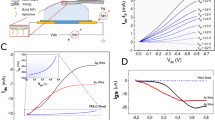Abstract
Controlling the surface wettability of a biosensor improves the sensitivity and limit of detection (LOD) in an electrical label-free detection. The sensing area is treated as hydrophilic and its outer surface is treated as hydrophobic by using a passivation layer composed of CYTOPTM. The hydrophilic sensing area enhances biomolecule interactions between receptors and analytes, whereas the hydrophobic outer sensing region suppresses them. Consequently, the sensitivity and LOD are improved by the increased analyte concentration during the biomolecule interactions. We varied the areal ratio of the hydrophobic region to the hydrophilic region and investigated its effect via detection of cardiac troponin I, which is a biomarker that is used in determining the prognosis of myocardial infarctions. Threefold of sensitivity and 3 orders of LOD in the hydrophobic passivation were improved over the non-passivation.



Similar content being viewed by others
References
Ishikawa, F. N., Chang, H.-K., Curreli, M., et al. (2009). Label-free, electrical detection of the SARS virus N-protein with nanowire biosensors utilizing antibody mimics as capture probes. ACS Nano, 3, 1219–1224.
Zhang, G.-J., Chua, J. H., Chee, R.-E., Agarwal, A., Wong, S. M. (2009). Label-free direct detection of MiRNAs with silicon nanowire biosensors. Biosensors and Bioelectronics, 24, 2504–2508.
Nair, P. R., & Alam, M. A. (2007). Design considerations of silicon nanowire biosensors. IEEE Transfer Electron Devices, 54, 3400–3408.
Elfstrom, N., Karlstrom, A. E., Linnros, J. (2008). Silicon nanoribbons for electrical detection of biomolecules. Nano Letters, 8, 945–949.
Kim, A., Ah, C. S., Yu, H. Y., et al. (2007). Ultrasensitive, label-free, and real-time immunodetection using silicon field-effect transistors. Applied Physics Letters, 91, 103901.
Grant, S. A., Xu, J., Bergeron, E. J., Mroz, J. (2001). Development of dual receptor biosensors: an analysis of FRET pairs. Biosensors and Bioelectronics, 16, 231–237.
Ko, S., Kim, B., Jo, S.-S., Oh, S. Y., Park, J.-K. (2007). Electrochemical detection of cardiac troponin I using a microchip with the surface-functionalized poly(dimethylsiloxane) channel. Biosensors and Bioelectronics, 23, 51–59.
Ko, S., Park, T. J., Kim, H.-S., Kim, J.-H., Cho, Y.-J. (2009). Directed self-assembly of gold binding polypeptide-protein A fusion proteins for development of gold nanoparticles-based SPR immunosensors. Biosensors and Bioelectronics, 24, 2592–2597.
Guo, S., Wen, D., Zhai, Y., Dong, S., Wang, E. (2010). Platinum nanoparticle ensemble-on-graphene hybrid nanosheet: one-pot, rapid synthesis, and used as new electrode material for electrochemical sensing. ACS Nano, 4, 3959–3968.
Hou, S., Kasner, M. L., Su, S., Patel, K., Cuellari, R. (2010). Highly sensitive and selective dopamine biosensor fabricated with silanized graphene. Journal of Physical Chemistry C, 114, 14915–14921.
Minton, A. P. (1999). Adsorption of globular proteins on locally planar surfaces. II. Models for the effect of multiple adsorbate conformations on adsorption equilibria and kinetics. Biophysical Journal, 76, 176–187.
Stenberg, E., Persson, B., Roos, H., Urbaniczky, C. (1991). Quantitative determination of surface concentration of protein with surface plasmon resonance using radiolabeled proteins. Journal of Colloid and Interface Science, 143, 513–526.
Lineweaver, H., & Burk, D. (1934). The determination of enzyme dissociation constants. Journal of American Chemical Society, 56, 658–666.
Cui, Y., Wei, Q., Park, H., Lieber, C. M. (2001). Nanowire nanosensors for highly sensitive and selective detection of biological and chemical species. Science, 293, 1289–1292.
Kim, J.-Y., Choi, K., Moon, D.-I., et al. (2013). Surface engineering for enhancement of sensitivity in an underlap-FET biosensor by control of wettability. Biosensors and Bioelectronics, 41, 867–870.
Im, H., Huang, X.-J., Gu, B., Choi, Y.-K. (2007). A dielectric-modulated field-effect transistor for biosensing. Nature Nanotechnology, 2, 430–434.
Kim, S., Ahn, J.-H., Park, T. J., Lee, S. Y., Choi, Y.-K. (2009). A biomolecular detection method based on charge pumping in a nanogap embedded field-effect-transistor biosensor. Applied Physics Letters, 94, 243903.
Gu, B., Park, T. J., Ahn, J.-H., Huang, X.-J., Lee, S. Y., Choi, Y.-K. (2009). Nanogap field-effect transistor biosensors for electrical detection of avian influenza. Small, 5, 2407–2412.
Kim, C. H., Jung, C., Lee, K. B., Park, H. G., Choi, Y. K. (2011). Label-free DNA detection with a nanogap embedded complementary metal oxide semiconductor. Nanotechnology, 22, 135502.
Kim, J. Y., Ahn, J. H., Choi, S. J., et al. (2012). An underlap channel-embedded field-effect transistor for biosensor application in watery and dry environment. IEEE Transactions Nanotechnology, 11, 390–394.
Kim, C. H., Jung, C., Park, H. G., Choi, Y. K. (2008). Novel dielectric-modulated field-effect transistor for label-free DNA detection. BioChip Journal, 2, 127–134.
Choi, D. H., Lee, S. K., Oh, Y. K., et al. (2010). A dual gold nanoparticles conjugate-based lateral flow assay (LFA) method for the analysis of troponin I. Biosensors and Bioelectronics, 25, 1999–2002.
Acknowledgments
This work was supported by the National Research and Development Program under grant NRDP 2005-2001274 for the development of biomedical function monitoring biosensors and by the Center for Integrated Smart Sensor through the National Research Foundation of Korea funded by the Ministry of Education, Science, and Technology under grant CISS-2012M3A6A6054187.
Author information
Authors and Affiliations
Corresponding author
Electronic Supplementary Material
Below is the link to the electronic supplementary material.
ESM 1
(DOC 142 kb)
Rights and permissions
About this article
Cite this article
Kim, CH., Ahn, JH., Kim, JY. et al. Improvement of Sensitivity and Limit of Detection in a Nanogap Biosensor by Controlling Surface Wettability. BioNanoSci. 3, 192–197 (2013). https://doi.org/10.1007/s12668-013-0081-x
Published:
Issue Date:
DOI: https://doi.org/10.1007/s12668-013-0081-x




